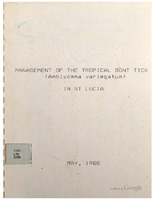| dc.contributor.author | Instituto Interamericano de Cooperación para la Agricultura (IICA) | |
| dc.contributor.author | Scotland, Keith | |
| dc.date.accessioned | 2021-05-12T20:30:39Z | |
| dc.date.available | 2021-05-12T20:30:39Z | |
| dc.date.issued | 1988 | |
| dc.identifier.uri | https://repositorio.iica.int/handle/11324/16358 | |
| dc.description | 64 páginas pdf. | es |
| dc.description.abstract | The document refers to the tropical bont tick (Amblyomma variegatum), which parasitises both domestic animals and wildlife. It was introduced into the Caribbean about 1830 when infested cattle were imported into Guadeloupe from West Africa. A. variegatum is an important vector of the rickettsia (Cowdria ruminantium), the causative agent of heartwater (cowdriosis) in ruminants which, when introduced into disease-free areas or when susceptible livestock are introduced into endemic areas, causes high mortality. Its eradication will increase revenue from livestock rearing and improve living conditions of the rural sector; provide an incentive for farmers to increase livestock production and improve management systems; reduce the threat of heartwater developing on the island; eliminate a source of tick infestation to neighbouring islands and the mainland countries of the hemisphere; and it will remove current restrictions on the export of livestock. | es |
| dc.language.iso | es | es |
| dc.publisher | Instituto Interamericano de Cooperación para la Agricultura (IICA) | es |
| dc.subject | SANTA LUCIA | es |
| dc.subject | GARRAPATAS | es |
| dc.subject | AMBLYOMMA VARIEGATUM | es |
| dc.subject | CONTROL DE ACAROS | es |
| dc.subject | CARIBE | es |
| dc.subject.other | Representación Santa Lucía | es |
| dc.title | Management of the tropical bont tick (Amblyomma variegatum) in St Lucia | es |
| dc.type | Libro | es |


